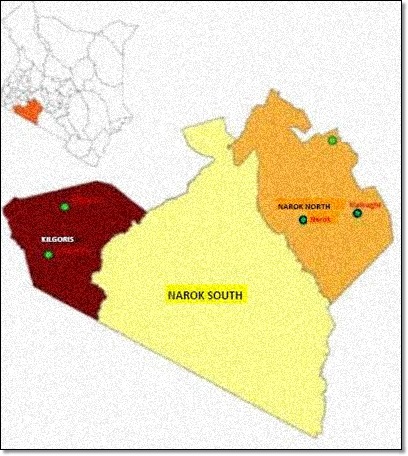Kenya@50: Narok County Still Consumes Unsafe Water

 |
| Kenya's Narok County |
After a half-century of independence, Narok County is yet to establish an elaborate water supply system and wastewater treatment facility. Although the county is home to the Mau Forest, one of the most important water towers in Kenya and an important source of water and livelihood to the growing population and the Maasai Mara Ecosystem. Water scarcity and consumption of untreated water is also a reality to its residents. According to Narok LRA Report 2013, the current water sources for both domestic and livestock use in the county are rivers, water pans, shallow wells, boreholes and springs. There are 61 water pans, 53 of which are operational, seven permanent springs, four permanent rivers and seven operational boreholes in the county.
It is estimated that the overall economic loss in Africa due to lack of access to safe water and sanitation is estimated at $28.4 billion a year. This loss is due to a number of factors. When people are sick, they are unable to work and produce for themselves and the economy. Also, they must get treatment which consumes a considerable amount of income. Throughout Narok County, water sources are contaminated with a wide variety of microorganisms and chemicals that cause typhoid, diarrheal diseases, cholera, intestinal worms, trachoma, schistosoma and other notoriously virulent diseases. Children are the most likely to become ill because their immune system is less developed and they dehydrate faster than adults.
Women and children bear the primary responsibility for water collection in most of households. It is women and children who are literally carrying the weight of the water problem. Research has shown that the current distance to water points in pastoral livelihood zones is about three kilometers doubling it to six for a trip of water, and two kilometres in the agro-pastoral and mixed farming livelihoods making it four kilometres. In Suswa area, ground water sources are unfit for human consumption. Households in these areas mainly rely on rain water harvesting and from water vendors during stress periods.
Women and children travel kilometres per day collecting water and carrying it. Fulfilling this daily responsibility leaves little or no time for women to pursue developmental opportunities and for children to do better in their education. Time is spent waiting at the source, although most households are getting water from rivers, springs and water pans/dams the waiting time is still significant because water sources are diminishing, in some areas like Mosiro, more time is needed to allow for recharge as scooping of sand is done in dry river beds. The United Nations estimates that Sub-Saharan Africa alone loses 40 billion hours per year collecting water. That is an entire year’s worth of work by the entire labor force in France – and so poverty continues.
Sanitation and Hygiene
Narok County does not have a centralized sewerage piping system. The residents rely on pit latrine but in the rural areas open defecation is common and this contributes to the contamination of rivers and pans when it rains. Bathing and cleaning of cars, motorbikes and clothes is done on the water sources and contributes to water contamination. These being the main water sources within the expansive pastoral areas, it predisposes the households to waterborne diseases since water is not treated before consumption.
The water treatment technologies and chemicals are not available at household level. Personal hygiene practices like washing of hands is very poor especially in the pastoral and agro-pastoral livelihoods. However, in mixed farming areas, the habit of hand washing before meals is generally practiced. Hygiene is not observed during food preparation and storage in the entire county.
Narok County should recognize that its water resource is finite and requires proper management. The county should ensure access to safe water for its residents and a water secure county because these will lead to reduction in poverty, advances education, and improved living standards for its residents.
By Mayiani Saino
The author is a MSc. Environmental Engineering student
University of Science &Technology Beijing, China.
